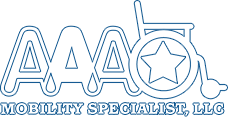Buying Used; Tips, Tricks and Red Flags
Much like buying a car, the investment into your mobility equipment is one that should be thought out, researched and planned for. In some cases, the investment into mobility can be a few hundred dollars, in other cases it can be thousands of dollars – so the goal is to invest wisely. In some situations that means purchased gently used or refurbished mobility equipment. In this blog you will find tips, a few tricks and the red flags for buying used equipment.
The best tip I can give you is making sure prior to shopping make sure you know what your needs will be. If you need mobility equipment to use in your home, make sure you know how wide your door frames are, how high the thresholds into your home are and how much general room you must maneuver around inside your home. If you have narrow hallways or doorways, you aren’t going to want to buy a full-size scooter or power chair because it won’t fit inside your home. If you’ve got a higher threshold, you’ll want to make sure you are purchasing mobility equipment with enough clearance to safely get inside and out of your home. If your primary use will be outside the home or community based, you might want to look for something with a longer battery life, foam filled tires (to avoid getting flat tires) and 4-wheels to ensure stability, especially if you’ll be traveling over multiple terrains. By knowing what your needs will be, you’ll create a blueprint for what type of equipment you need, helping you narrow down the type of equipment you’ll want to purchase.
Once you understand what your needs are, there are a few tricks I can share with you to make sure you are getting the best deal possible. If you are going to purchase from a private individual; the best thing you can do is the get manufacturer, make, model and serial number from the unit then using this information do some basic market research. First, call some local companies and ask what they would be selling a similar piece of equipment for. The next call I’d suggest making is to the manufacturer to see if the equipment still has a warranty on it and if that warranty is transferrable. If it does have a transferable warranty, make sure to ask what exactly the remaining warranty would cover. In most cases warranties cover parts, not labor, however some warranties work on a sliding scale while other last for a certain amount of time. If you are purchasing from a company, I recommend shopping around for the best warranty – most will cover parts, not labor, and always double check the length of the warranty.
Just like shopping for vehicles, there are few red flags you should watch out for when purchasing used equipment. If you are purchasing from Craigslist, or something similar, you want to make sure you inquire about the when the batteries had been replaced. Batteries are not cheap, if you’re told they were recently replaced, ask for a receipt and where the batteries were purchased from – if they can’t give you the answers, I strongly recommend walking away from the deal. Batteries start at anywhere from $180 to $500 depending on the type of equipment. Another red flag to watch out for is there are no serial numbers on the unit, each piece of equipment typically has 3 serial numbers on it in different locations. If they can’t provide you with at least one of the serial numbers, chances are something is off.
When purchasing used equipment, you always run the risk of purchasing a “lemon” but hopefully by following our tips and tricks and watching out for red flags you’ll be able to invest in a solid piece of equipment. If in doubt, reach out to a local company and ask them to do a quick evaluation on the equipment for you; most will for a reduced few – and as my Grandpa always said, “I’d rather spend a few dollars now if it saves me from spending a few thousand dollars later.”




 Powerhouse Group
Powerhouse Group